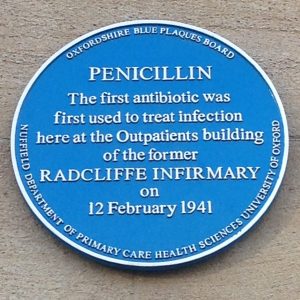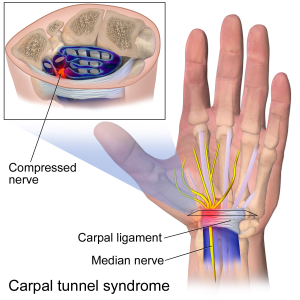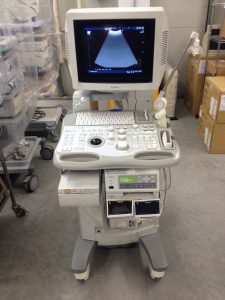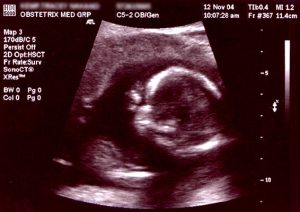
This page focuses on prefixes not covered in the previous sections. Some of these prefixes were introduced earlier in the book; however, their use can be complex, and it is important to understand these concepts fully. Examples and review exercises will be provided to help you learn and remember these important concepts.
Table 3.22. Prefixes
| PREFIX | MEANING | EXAMPLE OF USE IN A MEDICAL TERM |
| anti- | against | antibiotic |

As discussed in Chapter 2, antigens, which means “producing against,” are foreign substances such as bacteria, viruses, or fungi that enter the body. When a foreign substance enters the body, the body reacts by producing antibodies, a term that means “working against the bodies of the foreign substance.” If the foreign substance is a bacteria, your doctor would likely prescribe an antibiotic, a term that means “pertaining to” (-tics) “against” (anti-) “life” (bi/o). Fig. 3.23 is a plaque commemorating the use of the first antibiotic, penicillin (NHS, 2019).
Table 3.23. Prefixes
| PREFIX | MEANING | EXAMPLE OF USE IN A MEDICAL TERM |
| dia- | complete, through | diagnosis |
The prefix dia- (“complete”) is frequently used in medical terms; for example, in the term diagnosis, which most people are familiar with. Diagnosis means “pertaining to knowledge” (gnos/o -is) that is “complete” (dia-), or “complete knowledge.” Once a physician has all the necessary information to provide a patient with a proper diagnosis, they will often tell the patient their prognosis. This term literally means “knowledge before,” and in this situation, prognosis refers to how the physician feels a patient’s outcome will be with or without treatment.
There are several other medical terms that use the prefix dia-. The list below provides some examples, but you may hear others, especially in hospital specialty units:
Table 3.24. Prefixes
| PREFIX | MEANING | EXAMPLE OF USE IN A MEDICAL TERM |
| de- | from, down, away from | dehydration |
| eu- | good, normal | euphoria |
The term dehydration means “condition” (-ation) of “down” (de-) “water “(hydr/o). On average, a person requires four to six cups of water a day to avoid dehydration, but this may vary depending on a person’s activity level, the climate, and whether or not they have other health conditions that require them to drink more or less water based on a physician’s advice (Harvard Medical School, 2020).
Table 3.25. Prefixes
| PREFIX | MEANING | EXAMPLE OF USE IN A MEDICAL TERM |
| hemi- | half | hemiplegia |
The prefix hemi- (“half”) is used in a number of terms, especially those related to surgical procedures; for example:
The prefix hemi- is also used in terms related to symptoms that a patient might be experiencing; for example, hemiplegia, meaning “paralysis” (-plegia) of “half” (hemi-), might refer to paralysis of the right or left side of the body as a result of a cerebrovascular accident (CVA), or stroke. If a patient is experiencing paralysis of the lower half of their body, the term used is paraplegia. When a person has paralysis of all four extremities, this is called quadriplegia.
Table 3.26. Prefixes
| PREFIX | MEANING | EXAMPLE OF USE IN A MEDICAL TERM |
| sym- | together, with, joined | symbiotic |
| syn- | together, with, joined | syndrome |

Fig. 3.24 is an illustration of a common syndrome that may affect healthcare workers, carpal tunnel syndrome, from the suffix -al (“pertaining to”) and carp/o (“wrist”) . This condition is a type of repetitive strain injury (RSI) and can be caused by such activities as typing, overexertion, and various clinical tasks that require the use of fine motor skills (ReliasMedia, 2012).
Table 3.27. Prefixes
| PREFIX | MEANING | EXAMPLE OF USE IN A MEDICAL TERM |
| ultra- | beyond | ultrasonogram |


Ultrasonography, which means “process of recording” (-graphy) “beyond” (ultra-) “sound” (son/o), is commonly used to help diagnose the cause of pain or to assess for abnormalities or infections (RadiologyInfo.org, 2020). Fig. 3.25 is an image of ultrasound equipment that would be used by an ultrasound technician or radiologist. Fig. 3.26 is an obstetrical ultrasound that is used to assess the health of a fetus.
Attribution
Unless otherwise indicated, material on this page has been adapted from the following resource:
Carter, K., & Rutherford, M. (2020). Building a medical terminology foundation. eCampusOntario. https://ecampusontario.pressbooks.pub/medicalterminology/ licensed under CC BY 4.0
References
Image Credits (images are listed in order of appearance)
definitionPertaining to against life
× Close definitionA state of complete knowledge (this term is an exception to the rules; the suffix -sis means "state of")
× Close definitionThe condition of down (too little) water
× Close definitionA state of goodness
× Close definitionParalysis of half the body, usually caused by a cerebrovascular accident (stroke)
× Close definitionParalysis of the lower half of the body
× Close definitionParalysis of all four extremities
× Close definitionPertaining to together in life
× Close definitionA group of signs and symptoms that combine to form a syndrome
× Close definitionA record beyond sound
× Close definitionThe Language of Medical Terminology Copyright © 2022 by Lisa Sturdy and Susanne Erickson is licensed under a Creative Commons Attribution-NonCommercial-ShareAlike 4.0 International License, except where otherwise noted.